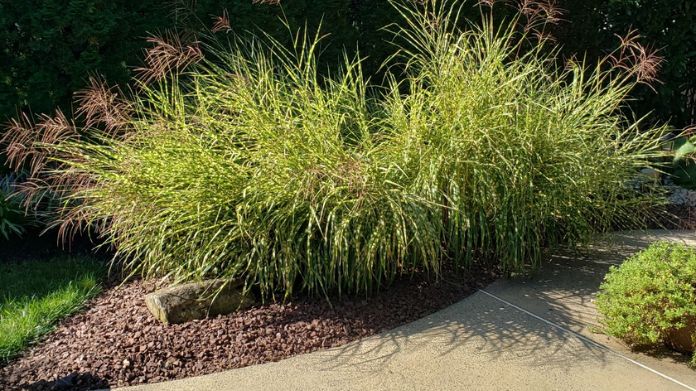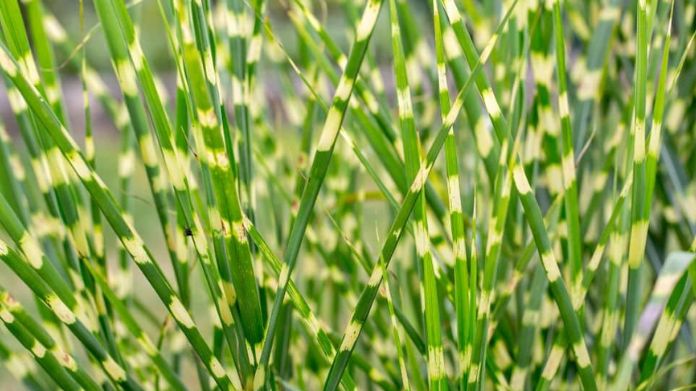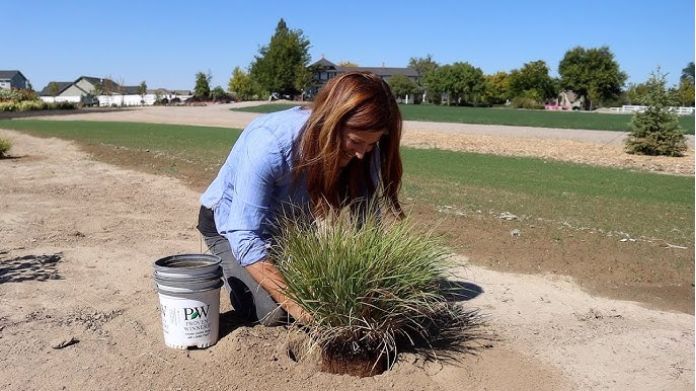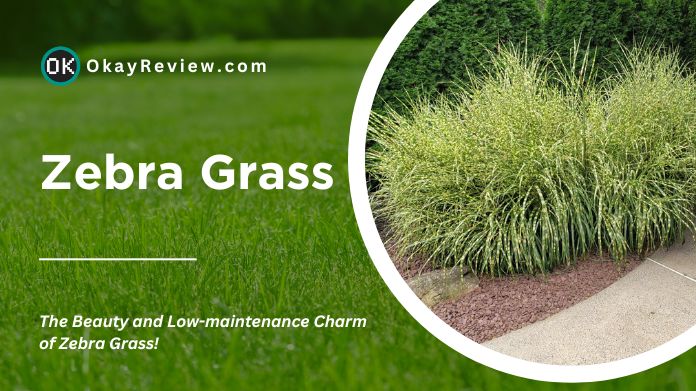Meet Zebra Grass, nature’s masterpiece! It is every gardener’s dream come true with its playful stripes and easy-going nature.
This ornamental grass jazzes up gardens with its zebra-like patterns and wins hearts with its low-maintenance character.
While considering the beauty of zebra grass, it is also important to examine practical options such as artificial grass for dogs.
Whether you’re a green thumb or just someone who loves a touch of green, Zebra Grass promises to bring beauty and simplicity to your outdoor space.
Dive in, and let’s explore the wonders of this delightful plant together!
Table of Contents
Zebra Grass: Origin and Botanical Information
 Zebra Grass, a captivating ornamental plant, traces its roots back to the lush landscapes of eastern Asia, particularly regions like Japan, China, Taiwan, and Korea. Scientifically known as Miscanthus Sinensis’ Zebrinus’, this grass belongs to the expansive Poaceae family.
Zebra Grass, a captivating ornamental plant, traces its roots back to the lush landscapes of eastern Asia, particularly regions like Japan, China, Taiwan, and Korea. Scientifically known as Miscanthus Sinensis’ Zebrinus’, this grass belongs to the expansive Poaceae family.
The name “Zebra Grass” isn’t just a whimsical title; it’s a nod to the plant’s distinctive horizontal cream bands that mimic the stripes of a zebra.
Delving into its botanical name, it’s derived from Greek words: “mischos,” meaning “stalk,” and “anthos,” signifying “flower.”
Beyond its beauty, Zebra Grass has a rich history and botanical significance, making it a visual treat and a topic of interest for plant enthusiasts.
Characteristics of Zebra Grass
Zebra Grass is a standout in ornamental plants, and its unique features make it a favorite among garden enthusiasts.
If you’re a fan of low-maintenance plants like Zebra Grass, you might also appreciate the simplicity of lawn dethatching.
Here’s a closer look at what makes Zebra Grass so unique:
1. Distinctive Stripes: “Zebra Grass” isn’t just for show. This grass is adorned with horizontal cream bands on its green leaves, giving it a zebra-stripe appearance. These stripes are eye-catching and add a touch of whimsy to any garden setting.
2. Height and Spread: Zebra Grass isn’t a shy plant. It can proudly reach heights of up to 7 feet, with a spread of 3-5 feet. It is perfect for creating natural screens or as a focal point in garden designs.
3. Flowering Beauty: Zebra Grass has another surprise in store in late summer. It produces silvery-white plumes that rise above its foliage. These flowers add to their aesthetic appeal and can last into the colder months, providing winter interest.
4. Seasonal Changes: Zebra Grass is a plant for all seasons. Its green leaves take on a golden hue as autumn rolls in, offering a warm and vibrant display. While the grass dies in winter, it springs back to life with the first signs of spring.
5. Adaptability: One of the reasons gardeners love Zebra Grass is its adaptability. It’s not particularly fussy about soil types and can thrive in various conditions, from full sun to partial shade.
6. Texture and Movement: The slender leaves of Zebra Grass add texture to garden designs. Moreover, when the wind blows, the grass moves gracefully, adding dynamism and a sense of movement to the landscape.
Ideal Growing Conditions
 Certain growing conditions allow Zebra Grass to thrive and showcase its unique beauty. First and foremost, sunlight is its best friend.
Certain growing conditions allow Zebra Grass to thrive and showcase its unique beauty. First and foremost, sunlight is its best friend.
Zebra Grass loves basking in full sun, which enhances its vibrant stripes and ensures healthy growth. While it’s adaptable, this ornamental grass prefers soil that’s roughly neutral in pH. This means it’s comfortable in a range from chalky to loamy grounds.
Watering is another key aspect. Especially in its initial growing phase, Zebra Grass appreciates consistent moisture. However, once matured, it showcases its hardy nature by being drought-tolerant.
But remember, while it can handle short dry spells, it’s always grateful for a drink during prolonged dry periods.
Space is another consideration. Given its potential height and spread, Zebra Grass needs room to stretch out and grow. So, when planting, ensure it has ample space to flourish without crowding its neighbors.
Planting Tips
 Planting Zebra Grass can be a rewarding experience, especially when you see it flourish in your garden.
Planting Zebra Grass can be a rewarding experience, especially when you see it flourish in your garden.
To ensure it grows healthy and strong, here are some straightforward planting tips:
1. Choose the Right Time: Spring or fall are the best times to plant Zebra Grass. If your region experiences early or harsh winters, opt for spring to give it ample time to establish before colder months.
2. Sunlit Spot: Zebra Grass thrives in full sun. When selecting a spot, ensure it receives sunlight for most of the day. This will help maintain its vibrant stripes and overall health.
3. Soil Matters: While Zebra Grass is adaptable, it prefers soil with a neutral pH value. Before you plant, add some compost or organic stuff to the soil to make it richer.
4. Spacing: Given its potential size, Zebra Grass needs room to grow. When planting multiple grasses, space them about 3-4 feet apart to avoid overcrowding and ensure proper air circulation.
5. Watering: After planting, water the Zebra Grass generously to help it settle. Keep the soil moist for the first few weeks to encourage root growth.
6. Avoid Waterlogged Areas: While Zebra Grass likes moisture, it doesn’t appreciate standing water. Ensure the chosen spot has good drainage to prevent root rot.
7. Mulching: Putting some mulch around the bottom helps keep the soil wet and stops weeds from growing. This can be especially beneficial during the initial growth phase.
Care and Maintenance
Nurturing Zebra Grass in your garden is a delightful endeavor, and with the proper care, this ornamental gem will flourish year after year.
Here’s a simple guide to ensure your Zebra Grass remains vibrant and healthy:
1. Regular Watering: Zebra Grass benefits from consistent moisture in its initial growth phase. Water it 2-3 times a week during the first season. Once established, it’s more drought-tolerant, but watering during prolonged dry spells is still a good idea.
2. Sunlight is Key: Ensure your Zebra Grass continues to bask in full sun. It not only accentuates its striking stripes but also promotes robust growth.
3. Fertilizing: In the spring, boost your Zebra Grass with a balanced, general-purpose garden fertilizer. It will encourage vibrant growth and enhance its overall health.
4. Pruning: Give your Zebra Grass a trim in late winter or early spring. Cut it back to about 5 inches to make way for fresh growth. It keeps the plant tidy and rejuvenates it for the upcoming season.
5. Monitor Soil Moisture: Zebra Grass appreciates moisture but doesn’t like soggy conditions. Ensure the soil has good drainage to prevent potential root rot.
6. Disease and Pest Watch: Generally, Zebra Grass doesn’t get sick quickly, and bugs don’t bother it much. However, always watch for any signs of distress and address them promptly.
7. Winter Care: In regions with colder winters, the dried stalks can be left in place. They act as a natural mulch, protecting the plant’s root system from freezing temperatures.
Propagation
Expanding your Zebra Grass collection or sharing its beauty with others is made easy through propagation.
This process allows you to create new plants from an established one. Here’s a beginner-friendly guide to propagating Zebra Grass:
1. Best Time: Spring is the ideal time for propagation, especially after Zebra Grass starts showing signs of new growth. It ensures the divisions have ample time to establish before winter.
2. Division Method: The most common method to propagate Zebra Grass is through division. Digging up a mature clump ensures you get as much of the root system as possible.
3. Separate the Clump: Once it is out of the ground, gently separate it into smaller sections using your hands or a sharp knife. Ensure each section has a good amount of roots attached.
4. Prepare the Soil: Enrich the soil with compost or organic matter before replanting the divisions. This provides a nutrient-rich environment for the new Zebra Grass plants to thrive.
5. Planting: Plant each division at the same depth as the original plant. Space them adequately, keeping in mind the mature size of Zebra Grass.
6. Water Generously: After planting, water the divisions thoroughly. This ensures the soil is packed around the roots and gives the water it needs to grow.
7. Monitor Growth: Keep an eye on the newly planted Zebra Grass divisions, ensuring they receive adequate water and sunlight. With the proper care, they’ll soon establish and start thriving.
Conclusion
Zebra Grass is an ornamental gem that offers beauty, versatility, and ease of care.
Its distinctive appearance, combined with its hardy nature, makes it a favorite among garden enthusiasts.

